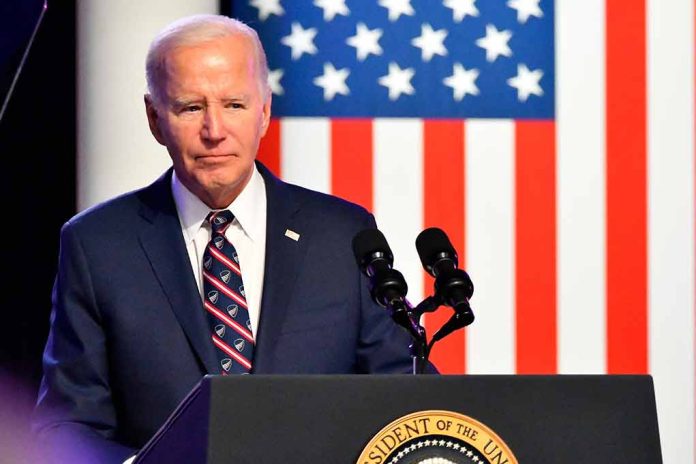
Amidst rising global tensions, President Biden has quietly signed off on a radical escalation in U.S. nuclear defense strategies.
At a Glance
- President Biden approved a highly classified nuclear strategic plan called “Nuclear Employment Guidance” in March.
- The plan reorients America’s deterrent strategy to focus on China’s expanding nuclear arsenal.
- The Pentagon believes China’s nuclear stockpiles will rival the US and Russia’s within a decade.
- The strategy prepares for potential coordinated nuclear challenges from China, Russia, and North Korea.
Biden’s Nuclear Employment Guidance
In March of this year, President Biden signed off on a highly classified nuclear strategic plan known as “Nuclear Employment Guidance”. This covert directive calls for bolstering the United States’ defensive posture against growing nuclear threats from China, Russia, and North Korea. The specific details of this plan remain under wraps, with physical copies of the document kept to a minimum.
This updated strategy shifts America’s deterrent focus, especially towards China, whose expanding nuclear arsenal is a pressing concern. According to Pentagon sources, China’s nuclear stockpile could match or even surpass that of the United States and Russia within the next decade. Addressing this challenge head-on, the plan emphasizes advancing missile defense systems and improving rapid response measures.
Global Nuclear Challenges
The updated guidance marks the first time the U.S. has explicitly prepped for simultaneous or sequential nuclear crises involving multiple adversaries. The threats from China, Russia, and North Korea are multifaceted, with each country demonstrating increased military cooperation. Notably, China and Russia conduct joint patrols near Alaska and engage in military exercises in the South China Sea.
“The president recently issued updated nuclear-weapons employment guidance to account for multiple nuclear-armed adversaries,” Vipin Narang, an M.I.T. nuclear strategist who served in the Pentagon, explained. “And in particular,” he added, “the weapons guidance accounted for the significant increase in the size and diversity of China’s nuclear arsenal.”
A critical concern arises with the upcoming expiration of the New START treaty with Russia in early 2026. This pivotal agreement. aimed at limiting inclusive intercontinental-range nuclear weapons, currently lacks a successor, intensifying the complexity of international oversight and arms control.
China, Russia, and North Korea in Focus
China potentially increasing its nuclear arsenal from 500 to 1,000 warheads by 2030, combined with Russia’s approximate 4,000 and North Korea’s recent doubling of its stockpile, underline the urgency of Biden’s secretive nuclear strategy. The White House clarified that the plan is not a response to any single country or threat. Still, the evolving global landscape has necessitated a proactive and more defensive stance from U.S. authorities.
The strategy demonstrates Washington’s willingness to expand its nuclear arsenal if China and Russia continue their strategic campaigns. The U.S. sees the necessity of matching and potentially surpassing their advancements to ensure national and global security.
A Strategic Shift in Nuclear Policy
With the secretive yet strategic command, President Biden’s administration has made clear that the era of single-adversary deterrence is over. The Pentagon’s readiness to confront coordinated nuclear confrontations involving Russia, China, and North Korea signifies a paradigmatic shift in U.S. nuclear policy.
“It was an important moment,” noted Richard N. Haass, President Emeritus of the Council on Foreign Relations. “We are dealing with a Russia that is radicalized; the idea that nukes wouldn’t be used in a conventional conflict is no longer a safe assumption.”
As Biden’s term progresses and ahead of a broader, unclassified notification to Congress, the global community remains watchful of how these developments will unfold and redefine the nuclear threat landscape.
Sources:
- Biden approves nuclear strategy refocusing on China threat – report
- Biden Approved Secret Nuclear Strategy Refocusing on Chinese Threat
- “Nuclear Threats and the Role of Allies”: Remarks by Acting Assistant Secretary of Defense for Space Policy Dr. Vipin Narang at CSIS
- Biden approves new nuclear strategy focussed on coordinated Russia-China threat
- Biden approved nuclear strategy focusing on China: Report
- Biden gave nod to strategy against coordinated nuke challenges from NKorea, China, Russia: Report
- Wednesday Briefing: The U.S.’s Secret Nuclear Strategy
- Biden orders US forces to prepare for potential nuclear confrontations with Russia, China, and North Korea










